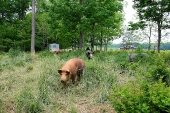




 The description on the 3D Warehouse page gives an overview of the system I have in mind, though here's a copy of the description:
The description on the 3D Warehouse page gives an overview of the system I have in mind, though here's a copy of the description:
Managed Intensive Grazing (MIG) setup for pigs and chickens. Central pig sty is fixed, providing eight gates for allowing hogs into various pasture areas. Fixed cross fencing provides four paddocks, 100 feet on a side each. Design allows ten pigs 5000 sq. ft. (half a paddock) of grazing for two weeks, completing one lap around the yard in sixteen weeks. 100 chickens rotate around a paddock, 2500 square feet per week, four weeks in one paddock, then rotate into area pigs vacate. Management of paddock rotation is such that chickens enter a space where pigs haven't been for two weeks, allowing parasites to die and forage to re-grow.




 1
1



























 1
1




 1
1




J.D. Ray wrote:I've just finished my Sketch-Up design for a Managed Intensive Grazing setup for pigs and poultry.
My project thread
Agriculture collects solar energy two-dimensionally; but silviculture collects it three dimensionally.

























Walter Jeffries wrote:In the winter the chickens eat pigs.
 2
2




 1
1




"You must be the change you want to see in the world." "First they ignore you, then they laugh at you, then they fight you, then you win." --Mahatma Gandhi
"Preach the Gospel always, and if necessary, use words." --Francis of Assisi.
"Family farms work when the whole family works the farm." -- Adam Klaus

|
Give a man a gun and he'll rob a bank. Give a man a bank and he'll rob everyone. Even tiny ads:
Learn Permaculture through a little hard work
https://wheaton-labs.com/bootcamp
|






